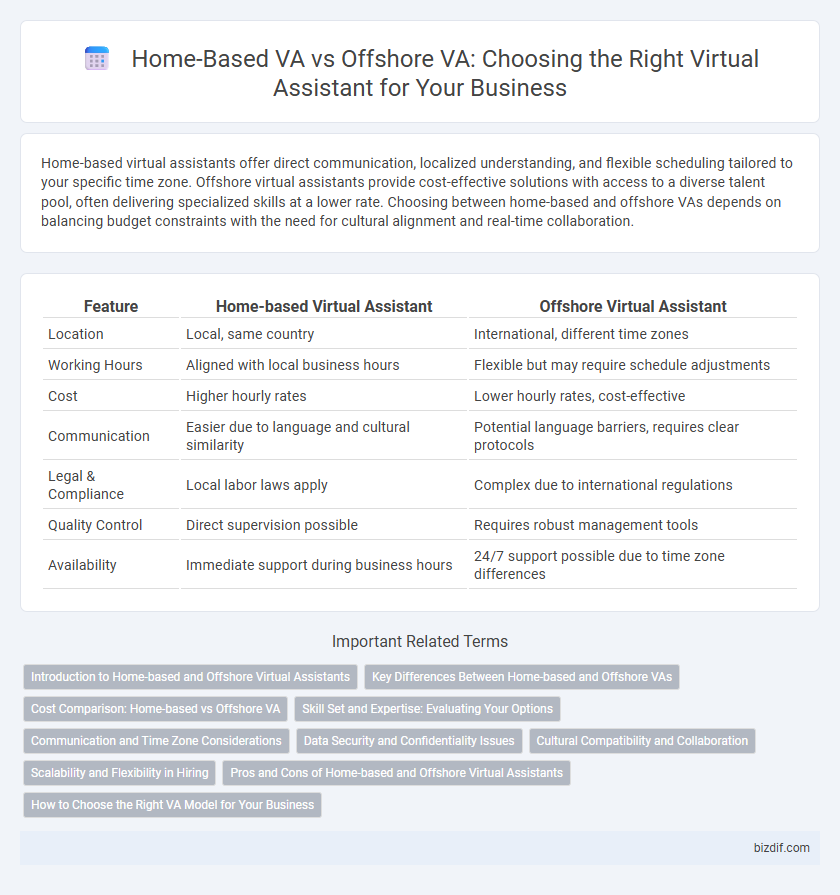Home-based virtual assistants offer direct communication, localized understanding, and flexible scheduling tailored to your specific time zone. Offshore virtual assistants provide cost-effective solutions with access to a diverse talent pool, often delivering specialized skills at a lower rate. Choosing between home-based and offshore VAs depends on balancing budget constraints with the need for cultural alignment and real-time collaboration.
Table of Comparison
| Feature | Home-based Virtual Assistant | Offshore Virtual Assistant |
|---|---|---|
| Location | Local, same country | International, different time zones |
| Working Hours | Aligned with local business hours | Flexible but may require schedule adjustments |
| Cost | Higher hourly rates | Lower hourly rates, cost-effective |
| Communication | Easier due to language and cultural similarity | Potential language barriers, requires clear protocols |
| Legal & Compliance | Local labor laws apply | Complex due to international regulations |
| Quality Control | Direct supervision possible | Requires robust management tools |
| Availability | Immediate support during business hours | 24/7 support possible due to time zone differences |
Introduction to Home-based and Offshore Virtual Assistants
Home-based virtual assistants typically operate within the same country as their clients, offering benefits such as cultural alignment, time zone compatibility, and easier communication. Offshore virtual assistants, often located in countries with lower labor costs, provide cost-effective solutions for businesses seeking to scale operations while managing budgets. Both models leverage digital tools and platforms to deliver administrative, technical, and creative support remotely.
Key Differences Between Home-based and Offshore VAs
Home-based virtual assistants typically operate within the same country as their clients, offering aligned time zones and cultural familiarity, which enhances communication and task understanding. Offshore VAs provide cost-effective services by leveraging lower labor costs in different countries but may present challenges such as time zone differences and language barriers. Choosing between home-based and offshore VAs depends on priorities like budget, communication efficiency, and specific task requirements.
Cost Comparison: Home-based vs Offshore VA
Home-based virtual assistants (VAs) typically command higher hourly rates due to local living costs and regulatory expenses, ranging from $20 to $50 per hour. Offshore VAs offer significant cost savings, with rates often between $5 and $15 per hour, driven by lower wage standards in countries such as the Philippines, India, and Eastern Europe. However, while offshore VAs reduce operational costs, factors like communication barriers and time zone differences can impact overall efficiency and project timelines.
Skill Set and Expertise: Evaluating Your Options
Home-based virtual assistants often provide specialized expertise with strong communication skills and familiarity with local market trends, making them ideal for tasks requiring cultural nuance and real-time collaboration. Offshore virtual assistants typically offer cost-effective solutions with diverse technical skills, multilingual abilities, and experience in handling repetitive or technical tasks across various industries. Assessing your project's complexity, desired skill depth, and communication preferences is crucial to selecting the most suitable virtual assistant option.
Communication and Time Zone Considerations
Home-based virtual assistants offer seamless communication with clients due to shared time zones and cultural familiarity, ensuring prompt responses and real-time collaboration. Offshore virtual assistants can provide cost-effective solutions but may face challenges in synchronous communication because of significant time zone differences and potential language barriers. Selecting a VA requires balancing communication efficiency and availability aligned with business needs and operational hours.
Data Security and Confidentiality Issues
Home-based virtual assistants typically offer enhanced data security and confidentiality due to operating within the same legal jurisdiction, enabling stricter compliance with local data protection laws such as GDPR or CCPA. Offshore virtual assistants may present increased risks related to data breaches and unauthorized access due to varying international privacy regulations and limited legal recourse. Implementing robust encryption protocols, NDAs, and secure communication channels is essential to mitigate these vulnerabilities regardless of the VA's location.
Cultural Compatibility and Collaboration
Home-based virtual assistants often share the same cultural norms and time zones, enhancing communication efficiency and collaboration on projects. Offshore virtual assistants bring diverse perspectives but may face challenges in cultural nuances and work schedule alignment, potentially impacting teamwork fluidity. Selecting a VA requires balancing cultural compatibility with cost and expertise to optimize collaborative outcomes.
Scalability and Flexibility in Hiring
Home-based virtual assistants offer greater flexibility in hiring due to local regulations and easier communication, allowing businesses to scale teams incrementally within familiar time zones. Offshore VAs provide enhanced scalability by accessing a larger talent pool at varying cost points, enabling rapid expansion across multiple markets. Companies can balance these options to optimize operational agility and resource allocation effectively.
Pros and Cons of Home-based and Offshore Virtual Assistants
Home-based virtual assistants offer advantages such as direct communication, cultural alignment, and increased accountability, but typically come with higher hourly rates and limited scalability. Offshore virtual assistants provide cost-effective solutions with access to a broader talent pool and 24/7 availability, yet challenges include potential language barriers, time zone differences, and varying work standards. Choosing between home-based and offshore VAs depends on priorities like budget, communication needs, and project complexity.
How to Choose the Right VA Model for Your Business
Choosing the right virtual assistant model depends on factors like budget, communication preferences, and required skills; home-based VAs often offer better cultural alignment and real-time collaboration, while offshore VAs typically provide cost savings and access to specialized expertise. Evaluate your business needs, time zone compatibility, and language fluency to maximize productivity and minimize miscommunication. Prioritize transparent communication channels and clear performance metrics to ensure the selected VA model aligns with your operational goals.
Home-based VA vs Offshore VA Infographic

 bizdif.com
bizdif.com